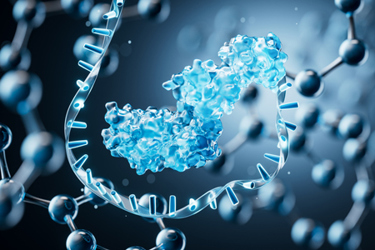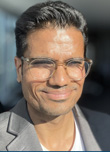Designing Our Way Toward Circular RNA Medicines With AI
A conversation with Kerry Benenato and Rajesh Ramaswamy, Sail Biomedicines

Despite the explosive potential of RNA medicines, several challenges have limited the development of translatable RNAs beyond the current collection of vaccines. On the pharmacology side, the inherent instability of linear mRNA results in short-duration protein expression, impacting efficacy and dosing. This has led to growing interest in the closed-loop structure of circular RNA, which can offer sustained, durable expression. Delivering RNA medicines to tissues outside of the liver has similarly presented challenges.
Sail Biomedicines’ Kerry Benenato (KB) and Rajesh Ramaswamy (RR) discuss efforts to leverage AI to decipher the biological and chemical codes that might resolve these issues, transforming a discovery process into an engineering project.
What is the biggest challenge in building a circular RNA platform company today, and why?
KB: The biggest challenge of any effort to build an RNA therapeutic is the sheer complexity of designing RNA molecules with the appropriate delivery vehicle that are not only efficacious but also tolerable, and this isn’t something that can be solved by the human brain. That is why, in conjunction with constructing an extensive platform for testing and data generation, Sail has invested so heavily in AI and machine learning.
In terms of circular RNA, specifically, the community needs to resolve the stability challenges of traditional modified mRNA, looking to extend the expression duration beyond the initial burst that rapidly drops as the RNA degrades. Less sensitive to degradation, circular RNA offers the opportunity for an extended expression window, which can significantly impact dosing and tolerability to patients.
The other piece to the challenge is developing an optimal delivery platform. You can have the best RNA in the world, but if you can’t deliver it to where you want to go in a safe and selective manner, then the industry is stuck with RNA medicines that only act in the liver or mRNA vaccines. Again, this is where AI has been vital to exploring the wider biological and chemical space of nature’s chemistries for nanoparticles.
What investments are Sail prioritizing (e.g., acquisitions, tech platforms, personnel) today that you feel will be helping you address these challenges?
KB: A key investment at Sail is in our people, their talent and their career development. Without the right team you’re not going to get anywhere. Therefore, a large focus at the senior leadership level is developing a culture that will enable our teams to be successful.
Another area of investment is in our technology platforms, leveraging high-throughput and automated systems to generate not just the volume of data needed for this undertaking but also the quality of data. Automated and controlled systems remove the burdens of tedious hands-on work, enabling our scientists to perform at a higher level, identifying the insights for which they were trained.
And finally, all this hinges on investments in digital infrastructure for data capture and data analysis, which empowers AI platforms and development.
RR: About 90% of the conversations Kerry and I have revolve around data generation. How do we generate this data set? At what scale can we generate data? What measurements can we make? What variables can we change? What variables can we not change? What kind of throughput can we get?
And then, this data needs to be captured systematically and maintained and documented and then appropriately used to teach machines to engineer medicine components that are increasingly better with every subsequent round of data generation. In this way, I see Sail as transforming the R&D process into an engineering enterprise with predictable outcomes.
I dislike using the word "discovery" to capture our process, because that would imply that we are hoping for something to happen, that we're hoping to find something. I take the view that we are trying to actively design and engineer a medicine to do the job we want it to do.
What specific AI techniques are you using and how are you addressing the challenges of working with AI?
RR: I look at medicine as a beautiful, nuanced, and complex piece of code that can be systematically engineered for therapeutic benefit. Whereas a computer code programs computer hardware for a specific outcome such as a specific calculation, the medicines that we are pioneering are meant to program the human body away from a state of disease into a state of health.
Like a well-crafted computer program, Sail’s RNA medicine construct is beautifully modular with distinct components, each performing a well-defined function. Fueled by large-scale data generation, what we are doing is teaching machines to iteratively master writing each module of the molecular construct to perform as required for therapeutic benefit.
This approach is analogous to iteratively engineering software for well-defined goals using large language model (LLM) agents. Computer programming with AI is made possible because we have succeeded in teaching LLMs to master human and human-made languages. Inspired by these advances, I am interested in designing and engineering medicines with AI by teaching machines to master the complex language of life.
Teaching machines to master the language of life is complex. As a result, we don’t just rely on a few AI techniques but, instead, we look across the entire AI space to develop and deploy AI systems for an intentional goal. For instance, we leverage deep learning architectures beyond transformers used in LLMs such as graph neural networks and diffusion models not only to cater to heterogeneous data modalities but also to make sure the right frameworks are used to tackle the right problem. Similarly, we not only use supervised learning for predictive tasks but widely use self-supervised learning to learn deep hidden patterns in data, all toward building a generative AI system to actively engineer components of the medicine. Essentially, we develop and deploy anything and everything to realize the goal of teaching machines to write the code to program the human body away from a state of disease into a state of health.
What advice would you give to other circular RNA companies navigating this growing/evolving space today?
KB: Focus. There is so much potential in the field, so much we can do. There are a lot of pieces to the problem. It would be so easy to dilute yourself and not make progress on anything by trying to work on everything. My advice is to have one clear line of sight to take advantage of the power of circular RNA and what it can do.
RR: It’s really important to have a clear product strategy and a focus on valuable products that you can bring to market ASAP. A technology like RNA is so versatile and potentially powerful that it can be easy to get lost in trying to make everything happen at once. If you end up creating nothing or little, you haven’t really extracted any value.
About The Experts:
 Kerry Benenato, Ph.D., has extensive experience in the development of mRNA products and product candidates. She currently serves as chief platform officer at Sail Biomedicines. Prior to Sail, she led development of a novel targeted protein degradation modality using mRNA/lipid nanoparticle technologies at 76Bio and led the delivery platform team at Moderna, with oversight of the discovery and development of mRNA delivery tools for multiple modalities and the development of tools for LNP biophysical characterization. Benenato held a research fellowship at Harvard University as an NIH Postdoctoral Fellow and received a Ph.D. in organic chemistry from Boston College and a B.S. in chemistry from Providence College.
Kerry Benenato, Ph.D., has extensive experience in the development of mRNA products and product candidates. She currently serves as chief platform officer at Sail Biomedicines. Prior to Sail, she led development of a novel targeted protein degradation modality using mRNA/lipid nanoparticle technologies at 76Bio and led the delivery platform team at Moderna, with oversight of the discovery and development of mRNA delivery tools for multiple modalities and the development of tools for LNP biophysical characterization. Benenato held a research fellowship at Harvard University as an NIH Postdoctoral Fellow and received a Ph.D. in organic chemistry from Boston College and a B.S. in chemistry from Providence College.
 Rajesh Ramaswamy, Ph.D., is a cross-industry engineering leader in artificial intelligence (AI), machine learning, computing, and data science. He currently serves as SVP, head of machine learning and artificial intelligence strategy at Sail Biomedicines and is responsible for building and deploying its AI systems to design and engineer medicines. Ramaswamy facilitated the launch of Sail Biomedicines as the architect of its AI nucleus. Prior to this, he founded and established the Data Driven Innovation office at EMD Serono that fueled the market launch of therapeutics across multiple disease areas by establishing enterprise-wide data science and machine learning capabilities. Prior to life sciences, Ramaswamy worked in quantitative finance, pricing and trading options using machine learning. He was an Alexander von Humboldt Research fellow at the Max Planck Institutes for the Physics of Complex Systems and Cell Biology & Genetics and received a Ph.D. in computer science from ETH Zürich, Switzerland.
Rajesh Ramaswamy, Ph.D., is a cross-industry engineering leader in artificial intelligence (AI), machine learning, computing, and data science. He currently serves as SVP, head of machine learning and artificial intelligence strategy at Sail Biomedicines and is responsible for building and deploying its AI systems to design and engineer medicines. Ramaswamy facilitated the launch of Sail Biomedicines as the architect of its AI nucleus. Prior to this, he founded and established the Data Driven Innovation office at EMD Serono that fueled the market launch of therapeutics across multiple disease areas by establishing enterprise-wide data science and machine learning capabilities. Prior to life sciences, Ramaswamy worked in quantitative finance, pricing and trading options using machine learning. He was an Alexander von Humboldt Research fellow at the Max Planck Institutes for the Physics of Complex Systems and Cell Biology & Genetics and received a Ph.D. in computer science from ETH Zürich, Switzerland.
